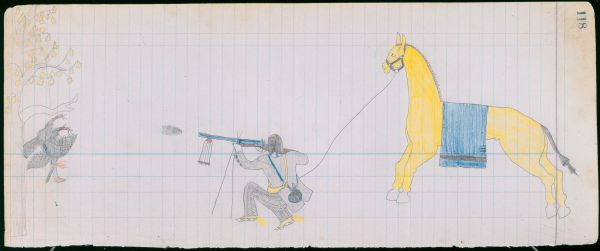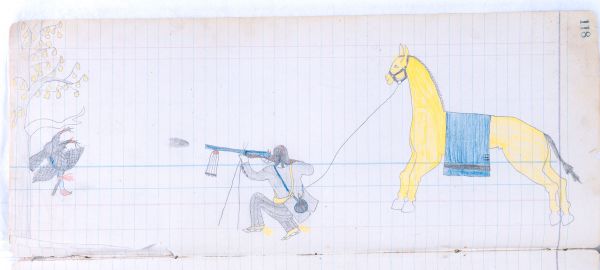PLATE 118
Ethnographic Notes
George Bent, wearing probably the same corduroy trousers as in Plate 92, again is shown hunting turkeys. Although the cross-hatched forestock is depicted differently in the two drawings, his shotgun probably is the same in both instances, too. Here we see that it is a double-barreled (two triggers), caplock weapon: both a powder horn and a shot flask are slung to Bent's shoulders. He is using crossed sticks as a brace, to aid in sighting. Tied to the muzzle of the shotgun is a fan of golden eagle tail feathers.
Bent wears partly-beaded moccasins, with their tops and long heel fringe painted yellow. His hair is arranged in Cheyenne fashion, with a circular, braided scalplock, and the parting of his hair painted red.
His mount is a buckskin mule---indicated by the long legs and ears, and the narrow tail. As a riding pad he uses a "three-point" blue wool trade blanket, with a black stripe at either end. Note that the animal is so well trained Bent can ride him without any reins, using only the lead line tied to the halter.
The time of day is either early morning or late afternoon, for the cock turkey has been roosting in a cottonwood tree. Its yellow leaves indicate the period is September or October. With admirable aim Bent kills the turkey with a neck shot, avoiding any damage to the meat, organs, or the feathers.
The Cheyenne word for turkey is Maxen (Moore, 1986: Fig. 5). They were so plentiful on the Southern Plains that Solomon River, a branch of the Republican, was named for them: Mazeneo Ohe, "River of Turkeys" (Grinnell, 1906: 17-18; Grinnell's spelling is Mahkine ohe). Cheyennes were especially fond of the tail feathers, with their irridescent, copper highlights.
"Turkey feathers or buzzard feathers were the best for [making] arrows, because blood does not affect them. Feathers of hawks and eagles, if wet with blood, are injured by the wetting" (Grinnell, 1923, I: 181).
Hunting turkeys was quite a popular Cheyenne pastime. For other Cheyenne depictions see Petersen, 1971: Plates 15, 40 & 49; or Wardwell, 1998: Plate 9.

